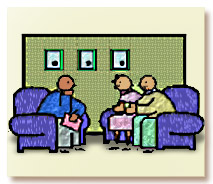
Last week I discussed some of the causal factors underlying suicidal behaviour. Suicide occurs when multiple stressors and loss deplete an individual’s internal resources. A person’s basic needs of safety, love and self-esteem are not being met. This leaves them in intolerable psychological pain; hopeless, helpless, and feeling completely alone. Suicide becomes the only solution they can see to end the pain.
What, then, can be done to stop suicide? The most important factor is prevention. This requires that individuals build strength and replenish their internal and external resources – something that can only be done over the long term. To begin building, however, it is necessary to first identify those at risk. Research in suicide prevention has discovered specific risk factors, and these can be used to assess level of risk for suicidal behaviour.
These factors, in descending order of importance, are:
– Age and Gender – certain ages and genders are more at risk
– Stress – a number of difficult experiences that challenge the ability to cope
– Symptoms – observable reactions to stress such as: mood changes, altered thinking, crying or withdrawal, problems sleeping, and attempts to cope through substance abuse.
– Current Suicide Plan – a specific, detailed plan exists.
– Prior Suicidal Behaviour. previous attempts, history of self-injury, others in family have “modeled” suicidal behaviour
– Resources – physical and emotional resources the person believes they have access to.
Age & gender: Although all ages and genders are affected by suicide, certain groups are at higher risk. Females attempt suicide more often, but males have more successful completion rates, outnumbering females four to one. Contrary to what many believe, overall suicide rates are not higher among teenagers. For women, suicide rates are highest in the 35-54 age range, while for men the highest are ages 20-24, followed by 30-45. Rates are the highest among divorced persons, and lowest among married. The preferred method among males is hanging, followed by shooting, inhaling, ingesting, and jumping. For females the preferred method is ingesting, followed by inhaling, hanging, shooting, and jumping (SIEC, ACICR, Statistics Canada).
It should be noted that the age and gender related suicide rates are quite different for Canada’s aboriginal population. For this group, suicide is the second leading cause of death overall, with young native males at greatest risk. For males, the highest rate is ages 20-29, followed closely by ages 15-19, then 30-34. For females the 15-19 year old group is highest, followed by ages 20-29.
Stress. A person who has had multiple stressors is at increased risk. These could include a death in the family, job loss, separation or divorce, financial problems, or abuse. The final stimulus for suicide may appear to be something very small, but it represents the culmination of troubling experiences that have depleted an individual’s ability to cope.
Symptoms. A person may be at risk if they demonstrate certain observable stress responses. These can be mood changes, sadness, narrowed thinking, crying spells, withdrawal, eating/sleeping changes, or substance abuse. They may behave recklessly, lose interest in activities, and become careless about their personal appearance. Sometimes they give away possessions, and make comments like, “everyone would be better off without me,” or “all of my problems will end soon.”
The foregoing are all indicators of increased risk of suicide, but the following three are considered the most important in assessing high suicidal risk: Current suicide plan, Prior suicidal behaviour, and Resources – known as suicide “CPR.” When confronted with a person you suspect may be suicidal, it is important to ask direct questions in order to determine whether these three indicators are present.
Current Suicide Plan. Does the person have a plan? How detailed is it? Have they decided when and where? Do they have access to a weapon (firearm, car/garage, pills, etc.)?
Prior Suicidal Behaviour. Have they ever attempted to harm themselves before? If so, they are 40 times more likely to succeed the next time. Has a family member or friend “modeled” suicidal behaviour? If a close family member has been successful in suicide, this validates it as an acceptable response to stress.
Resources. This is the most important factor – the physical and emotional resources the person feels are helping, caring and supportive. These can include other persons, groups, economic assets, etc. How alone does the person perceive their self to be?
Determining risk factors is only the first part of intervention. Knowing how to help is next – and it is the most difficult part. Many people are shocked by the notion of suicide, and say and do unhelpful things. All too often they will deny the thoughts, or say, “things could be worse,” or “things are not as bad as you think.” These comments might be intended to cheer the person up, but they do not validate how they are feeling. Before trying to make things better, we need to find out just “how” sad they feel, and just “how” bad things are.
The Intervention Model consists of three parts: exploration, understanding and action.
1. Exploration – “I Care” – You have noticed the person is upset or believe them to be at risk. Engage them with open-ended questions, but remember that it is hard for people to tell their story, so be patient. What are they feeling? Why have their coping mechanisms become so depleted that suicide is an option? Avoid cheerleading – statements like “think of all the great things you have” are meaningless. Don’t try to force them into anything – remember that a person who has reached this stage already feels powerless – don’t reinforce that by attempting to take their power away. Let them know you understand, but be careful not to turn the conversation into one about your own failings – keep focusing on them. Ask them what they are thinking of doing, but be specific. If a person is in extreme pain, asking, “are you going to hurt yourself?” won’t get the right answer – death is not hurting them, it is perceived as ending the pain.
2. Understanding – “I Hear” – Try to listen from their perspective and understand why they feel as they do. Assess their risk level (current plan, prior suicidal behaviour, resources available). Take your time and do not be afraid of silence – listening is more important than speaking. Always show respect and sensitivity and do not take away their dignity. Encourage life-sustaining thought patterns.
3. Action – “I Will Help” – Work with the person to develop and agree upon a proper action plan, keeping in mind that the goal is to stop the immediate risk. There are three possibilities here, and they depend on the level of risk. To the greatest degree possible, the goal is that the person should arrive at their own solution.
a. Non-directive approach. The person can decide their own plan of action. Effective for those who are low risk and have good internal resources.
b. Cooperative approach. Brainstorm a solution together. Address their ambivalence by offering them hope, negotiate.
c. Directive approach. This should only be used with extremely high risk, crisis situations. You take responsibility and offer only one plan.
We hear much about making a “contract” with a person who is suicidal. This is simply an agreement you reach with the person that allows them to have thoughts of suicide but prevents acting on them. This is most effective once you have determined an action plan, since they require a sense of hope that something will be done before they will agree to postpone suicide. The contract must be specific, is highly individual, and it may need to be made more than once. For example,
“I promise not to hurt myself *until tomorrow/without talking to you first*, and we will talk to *counsellor/friend/resource* to try to solve the problem.”
Don’t offer involvement if you can’t follow through, but do provide hope. If resources are unavailable, take even smaller steps along the way. Keep working toward life sustaining activities, develop the ambivalence, and try to access and build on internal resources – if you can keep them alive, internal resources can be rebuilt.
Suicide affects everyone and takes a terrible toll on our society, yet it is preventable. I would encourage everyone to take the time to learn all you can about suicide, and do your part toward increasing understanding and bringing the topic out into the open. Education, understanding, and removal of the stigma; followed by open dialogue about suicide, will go a long way toward reducing risk and saving lives.
References & further information:
SIEC: Suicide Information and Education Centre. http://www.siec.ca/sptp/index.htm
Canadian Mental Health Association: http://www.cmha.ab.ca/
ACICR: Alberta Centre for Injury Control & Research (2001). Suicide in Alberta, Data Report, 1993-1997.
Suicide Facts. http://www.med.ualberta.ca/acicr/
Statistics Canada: http://www.statscan.ca
Maslow’s Hierarchy of Needs: http://web.utk.edu/~gwynne/maslow.HTM
Schneidman, E (1985). Definition of Suicide. John Wiley & Sons. See: http://www.sccenter.org/understanding.html
World Health Organization. Suicide statistics worldwide.
http://www5.who.int/mental_health/main.cfm?p=0000000149
NEXT WEEK!

Many of you may enjoy watching reality TV, and are planning on watching the newest episodes of Canada’s Popstars: The One, that began airing last Thursday on Global TV. One of my daughters is a finalist, and will be appearing on the show, beginning with the Edmonton audition episode. Her experience has been an extremely interesting one, and starting next week I will be sharing with Voice readers what it was like, and how it has affected her and our family. Neither she nor I agree with the manufactured pop star concept, so we have been very ambivalent through the whole process. As proud as I am of her accomplishments, watching her on national TV and hearing and reading things that are being said about her performance is going to be both exciting and stressful. I know many of you already feel you know me and my family quite well through my writing, so I hope you will enjoy this very personal glimpse into our lives. When you watch the episode, look for a red-head named Amaya. Check out detailed episode information online at www.popstars.ca.
Next week: Popstars – the first audition
Debbie is a native Edmontonian, and a single parent with four daughters. She has worked as a professional musician for most of her life, and has enjoyed a rich variety of life experiences – with many more to come! Debbie is working towards an eventual doctorate in psychology, and currently serves as the president of the Athabasca University Students Union.

